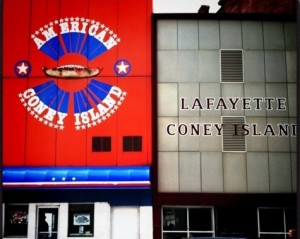If you’re ever suddenly saddled with a craving for a chili dog in downtown Detroit, you’re going to face a dilemma. Do you go to Lafayette Coney Island or American Coney Island???
The two age-old hot dog establishments sit right next to each other in just about as bustling a district of the Motor City can get these days. Their menus are almost identical, their prices hardly differ, and the best tasting title is debated daily by Detroit natives and nationwide food experts.
Of course there’s really no wonder why they’re so alike – even though they are completely seperate businesses they were both started by members of the Keros family. For the record, American Coney Island was there first and it had the market cornered, on that street corner nonetheless, until an argument erupted among siblings. One of the brothers decided not only to walk out on the business but he walked over one lot and started a new business which he named Lafayette Coney Island after the street it sits on. Tensions in the family have since cooled but the competition remains hot as both restaurants work hard to be the top dog.
So how on earth do two twins continue to operate side by side, year after year, without one overtaking the other? It may be a question only suitable for the host of “Man V. Food,” but we here at entreQuest have cooked up our own Coney Island ideas.
If you stand outside the two for about three minutes, a few differences will present themselves. First is their appearances – American is colorful, vibrant, fresh, and fun. Lafayette looks more like a local dive where things haven’t changed much. Second is their respective customers entering their doors – families and out-of-towners and anyone with a camera is drawn to American whereas workers on their lunch break and “regulars” are more often witnessed stopping by Lafayette.
Talk to Detroiters and they’ll tell you Lafayette has the edge when it comes to the more delicious chili dog. Check out the Internet and most of what comes up is all about American. Lafayette doesn’t even appear to have a website while American's online shop (http://www.americanconeyisland.com/home.htm) offers Coney Kits to be shipped right to your home.
It’s starting to make sense, right? Both Coney Island establishments in Detroit have carved out their own niche market to appeal to two different types of tube steak-holders, so to speak.... In the end, both restaurants probably help each other by increasing traffic into the area and boosting publicity for the chili dog offering. It’s critical, however, that both maintain the unique value of their solution to their particular prospects' all-encompassing cravings when their target market faces the dilemma of which Coney Island to go to.
Even if the competition you face as you go to earn your prospects’ business and keep your clients’ accounts is fiercer than that between American Coney Island and Lafayette Coney Island, you can still succeed by creating value-based solutions just like the hot dog vendors did.
It all comes down to one truth and one task. The truth: the perceived value must be higher than the investment. The task: fulfill the prospect’s/client’s ends need. It’s not just about a hot dog with chili on top. Some foodies need a friendly atmosphere, others need to know they’re in with the locals. Who is it that YOU are catering to and how can you make their experience VALUABLE?
Read more on creating value-based solutions in an article published by entreQuest in SmartCEO magazine available at this link: http://www.entrequest.com/wp-content/pdf/entrequest_solutions_09.04.pdf?phpMyAdmin=d2c4aa6766ft5760658.
Jeremy Steinberg is an Outsourced VP of Sales at entreQuest who has led companies across the country to increases in revenue by driving the performance of their sales teams to unprecedented levels of achievement.








